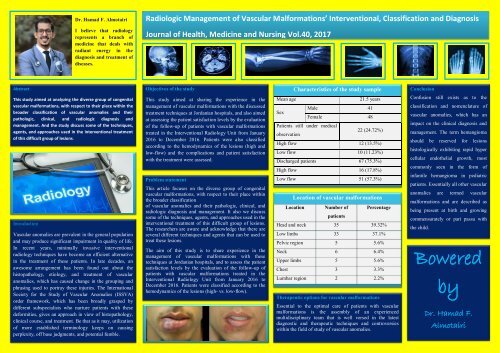You also want an ePaper? Increase the reach of your titles
YUMPU automatically turns print PDFs into web optimized ePapers that Google loves.
Dr. Hamad F. Almotairi<br />
I believe that radiology<br />
represents a branch of<br />
medicine that deals with<br />
radiant energy in the<br />
diagnosis and treatment of<br />
diseases.<br />
Radiologic Management of Vascular Malformations’ Interventional, Classification and Diagnosis<br />
Journal of Health, Medicine and Nursing Vol.40, 2017<br />
Abstract<br />
Objectives of the study<br />
Characteristics of the study sample<br />
Conclusion<br />
This study aimed at analyzing the diverse group of congenital<br />
vascular malformations, with respect to their place within the<br />
broader classification of vascular anomalies and their<br />
pathologic, clinical, and radiologic diagnosis and<br />
management. And the study discuss some of the techniques,<br />
agents, and approaches used in the interventional treatment<br />
of this difficult group of lesions.<br />
Introduction<br />
Vascular anomalies are prevalent in the general population<br />
and may produce significant impairment in quality of life.<br />
In recent years, minimally invasive interventional<br />
radiology techniques have become an efficient alternative<br />
in the treatment of these patients. In late decades, an<br />
awesome arrangement has been found out about the<br />
histopathology, etiology, and treatment of vascular<br />
anomalies, which has caused change in the grouping and<br />
phrasing used to portray these injuries. The International<br />
Society for the Study of Vascular Anomalies (ISSVA)<br />
order framework, which has been broadly grasped by<br />
different subspecialists who nurture patients with these<br />
deformities, gives an approach in view of histopathology,<br />
clinical course, and treatment. Be that as it may, utilization<br />
of more established terminology keeps on causing<br />
perplexity, off base judgments, and potential fumble.<br />
This study aimed at sharing the experience in the<br />
management of vascular malformations with the discussed<br />
treatment techniques at Jordanian hospitals, and also aimed<br />
at assessing the patient satisfaction levels by the evaluation<br />
of the follow-up of patients with vascular malformations<br />
treated in the Interventional Radiology Unit from January<br />
2016 to December 2016. Patients were also classified<br />
according to the hemodynamics of the lesions (high and<br />
low-flow) and the complications and patient satisfaction<br />
with the treatment were assessed.<br />
Problem statement<br />
This article focuses on the diverse group of congenital<br />
vascular malformations, with respect to their place within<br />
the broader classification<br />
of vascular anomalies and their pathologic, clinical, and<br />
radiologic diagnosis and management. It also we discuss<br />
some of the techniques, agents, and approaches used in the<br />
interventional treatment of this difficult group of lesions.<br />
The researchers are aware and acknowledge that there are<br />
several different techniques and agents that can be used to<br />
treat these lesions.<br />
The aim of this study is to share experience in the<br />
management of vascular malformations with these<br />
techniques at Jordanian hospitals, and to assess the patient<br />
satisfaction levels by the evaluation of the follow-up of<br />
patients with vascular malformations treated in the<br />
Interventional Radiology Unit from January 2016 to<br />
December 2016. Patients were classified according to the<br />
hemodynamics of the lesions (high- vs. low-flow).<br />
Mean age<br />
Sex<br />
Patients still under medical<br />
observation<br />
21.5 years<br />
Male 41<br />
Female 48<br />
22 (24.72%)<br />
High flow 12 (13.5%)<br />
Low flow 10 (11.23%)<br />
Discharged patients 67 (75.3%)<br />
High flow 16 (17.8%)<br />
Low flow 51 (57.3%)<br />
Location of vascular malformations<br />
Location<br />
Number of<br />
patients<br />
Percentage<br />
Head and neck 35 39.32%<br />
Low limbs 33 37.1%<br />
Pelvic region 5 5.6%<br />
Neck 6 6.4%<br />
Upper limbs 5 5.6%<br />
Chest 3 3.3%<br />
Lumbar region 2 2.2%<br />
Therapeutic options for vascular malformations<br />
Essential to the optimal care of patients with vascular<br />
malformations is the assembly of an experienced<br />
multidisciplinary team that is well versed in the latest<br />
diagnostic and therapeutic techniques and controversies<br />
within the field of study of vascular anomalies.<br />
Confusion still exists as to the<br />
classification and nomenclature of<br />
vascular anomalies, which has an<br />
impact on the clinical diagnosis and<br />
management. The term hemangioma<br />
should be reserved for lesions<br />
histologically exhibiting rapid hyper<br />
cellular endothelial growth, most<br />
commonly seen in the form of<br />
infantile hemangioma in pediatric<br />
patients. Essentially all other vascular<br />
anomalies are termed vascular<br />
malformations and are described as<br />
being present at birth and growing<br />
commensurately or pari passu with<br />
the child.<br />
Bowered<br />
by<br />
Dr. Hamad F.<br />
Almotairi


